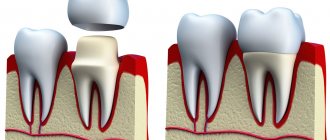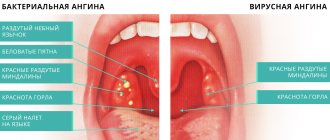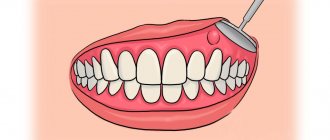Content
- Causes of tooth decay
- Signs
- Dental diagnostics
- Methods of dental treatment
Pathological changes in teeth restored with crowns are an extremely unpleasant situation and, moreover, dangerous for the health of the entire body. With the correct use of a well-made and installed crown, the likelihood of such problems occurring is minimized. However, cases of tooth decay under crowns still occur. It is important to recognize the problem in time and seek help from a doctor.
PROMOTION
Zirconium crowns and bridges
RUB 12,500
Why does the tooth turn black?
Crowns help restore the integrity of the dentition and maintain the structure of periodontal tissue. If before prosthetics the color of the unit was natural, and the transformation occurred subsequently, then the reasons for the darkening of the tooth may be
:
- Imperfect processing and unskilled treatment of a decaying tooth before prosthetics.
- Ignoring a crack in a ceramic crown. Especially from the reverse side, when there is no violation of visual aesthetics.
- Formation of a pocket between the gum and crown. Radical caries begins, bacteria and food debris get under the crown.
- The appearance of a gap between the crown and the ledge formed during tooth processing. Why does this happen? Perhaps the impression was taken incorrectly or the technician made an error. Or the patient refused a temporary crown, and minor deformation of the ledge occurred between treatment and installation.
Sometimes a patient has a metal-ceramic crown, and he is worried because of a dark stripe in the root zone of the chewing tooth. It is worth visiting a doctor, but for the most part, the reason is that the frame below is not covered with a sufficient layer of ceramics and over time begins to show through. The integrity of the prosthesis is not threatened. The defect is only aesthetic.
Another point:
the front teeth or molars may be over-prepared, under the gum. Soft tissues may react with recession, part of the enamel between the gum and the denture will be exposed and the process of destruction will begin.
Also the cause may be somatic ailments, metabolic disorders, chronic gastrointestinal diseases.
Why does a tooth rot under a crown?
The emergence of a pathological process occurs for a number of reasons. All of them are united by the same outcome - the penetration of pathological microorganisms. Among the most common causes of rotting are:
- Poor hygiene. If the patient does not keep his teeth clean and his oral cavity healthy, plaque accumulates on the teeth and tartar forms. These processes are accompanied by damage to the gums that protect the cervical part. The root of the tooth and the junction with the crown are exposed to destructive effects.
- Bad habits, unhealthy diet.
- Lack of calcium, bone tissue pathology.
- Secondary caries, decementation and food getting under the crown. Food rots, causing tooth decay.
What to do if the tooth has darkened
You just need to come to the clinic for a consultation. We will remove the prosthesis and find out the cause of the strange sensations. If the crown has already been removed and a darkened tooth is visible, we will consider options for saving it. First you need to determine the condition of the root and undergo a course of treatment. In the case when it is already destroyed, removal of the remains will be required, followed by implantation.
Is there a healthy root? Then you can install new crowns on your teeth quickly using Cerec technology
.
New technology eliminates errors. This is an opportunity to make ideal dentures and quickly cover a tooth with a crown. Steps:
- The scanner determines the characteristics of the damage; adjacent and opposite units and closed rows are scanned.
- The program combines information and creates a 3D model of inlays and crowns, taking into account anatomical features. The computer calculates the dimensions of the prostheses and the nuances of their shape.
- Even before the process begins, the patient can see the result. We select the shade - each change is agreed with the patient.
- A special machine makes an inlay and a crown from a blank.
- During fitting, it is rare, but the need for correction arises. In most cases, these are nuances of the shade of the crown. But a new copy according to the template is made within 15 minutes
. - The crown or inlay fits tightly to the remaining parts of the tooth, preventing pathogenic microflora from entering the tissue.
The process takes only 1.5 hours and allows you to save a darkening tooth. This technology is the best that has been created in dental practice. Allows you to quickly and accurately produce single versions of crowns for teeth or bridges from metal-free materials - ceramics and zirconium dioxide. We will discuss the nuances of your particular case during your visit; the cost of installing a crown on a tooth starts from 27,900 rubles. There are promotions and special offers. Keep your teeth healthy and your body will thank you.
Signs of tooth decay under the crown
The first thing the owner of a crown notices is bad breath. Brushing, rinsing, and flossing do not help eliminate it, or give short-term results. Manifestations other than odor:
- Mobility of the crown or tooth.
- Darkening of the visible part.
- Recession of the gums, exposure of the cervical area.
- Unpleasant, purulent taste in the mouth.
- Discharge of pus.
- Redness of the gums.
Re-prosthetics for severely damaged teeth
Every dentist in his practice very often encounters the task of repeated dental prosthetics. And as a rule, after removing old structures, a thin stump of a tooth that has been aggressively treated for a crown is discovered. This is due to outdated principles of prosthetics, when there was no talk of adhesive fixation.
Repeated prosthetics are caused by a number of problems awaiting the doctor, such as: root caries and violation of biological width, lack of ferrule effect, as well as complete destruction of the stump.
The question arises, how can one predict recovery and accurately outline a treatment plan for the patient before removing the old structure?
The answer is simple - this cannot be done for sure! Therefore, in my practice I apply the principle of “diagnostic autopsy”. Patients with such a clinical situation, after being informed of possible treatment options, are offered a diagnostic visit, after which a final decision will be made whether to preserve or remove the tooth.
What does a “diagnostic autopsy” consist of: old structures are removed, the condition of hard tissues, effect ferrules and periodontal tissues is assessed, as well as the possibility of their restoration. Temporary structures are made for the patient using the key made before the old structures were removed and further actions are discussed.
Let's look at the stages of treatment using a clinical example.
Photo 1. Metal-ceramic crowns connected together were previously installed on teeth 1.1, 2.1. Probing revealed overhanging edges of the crowns, as well as a deep subgingival location of the crown border on tooth 1.1.
Photo 2. Before removing the crowns, a silicone key was made.
Photo 3. After removing the old structures, the condition of the root and stump of the teeth was assessed. A violation of the biological width is also visible.
Photo 4. The remains of the composite and areas of carious lesions were removed with a bur. An ultrasonic nozzle was used to clean the cervical area of the teeth. CBCT shows normal endodontic status. Therefore, retreatment of the canals would be required only in the case of depressurization on the endoaccess side. An attempt to extract such a volume of pins is fraught with excessive thinning of the root and, as a consequence, the impossibility of preserving the teeth.
Photo 5. To restore the biological width, as well as enhance the ferrule effect, surgical lengthening of the crown part of the teeth was performed. Gingivoplasty in area 2.1 and gingivosteoplasty in area 1.1. After suturing, temporary restorations were made using a silicone key for 2 weeks.
Photos 6, 7. After 2 weeks, the stumps were restored with Core composite after sandblasting with aluminum oxide. Impressions were taken for laboratory temporary restorations.
Photo 8. Condition of soft tissues at the time of fixation of temporary single structures made of CAD/CAM composite.
Photos 9, 10. Condition of soft tissues after 1 year of wearing temporary structures.
Photo 11. The CAD/CAM system allows you to repeat the formed perigingival contour of temporary restorations in permanent structures, which is undoubtedly a big advantage and ease of use.
Photo 12. Immediately after fixation of ceramic crowns made of solid milled press ceramics, tooth 1.2 was temporarily restored with packable composite in a layer-by-layer technique, for financial reasons of the patient.
Subsequently, it is possible to make an exact copy of a ceramic veneer for tooth 1.2 by comparing digital scans before and after preparation.
Photos 13, 14. Follow-up examination after 1 week. The structural, functional and aesthetic parameters of the teeth are restored, and a healthy gum condition is achieved.
What to do if the gums near the implant have darkened
Answering this question, we immediately note that darkening of the gums near the implant and the occurrence of peri-implantitis are highly treatable and allow you to solve the problem in a short time.
Of course, as soon as you notice any changes in the area of the installed dental implant, you must immediately consult a doctor to determine the exact reasons for their development, make a diagnosis and carry out the necessary amount of treatment.
Already at the initial appointment, the doctor at the Apex dental clinic will conduct an objective examination and determine a further treatment plan. The specialist will tell you what you can do at home if the gums near the implant have darkened, and will also confirm whether the gums really turned blue after implantation - or in your case this is normal during the rehabilitation period.
A late visit to a specialist is fraught with the development of more serious complications, and therefore we strongly recommend not delaying your visit to the doctor.
Causes of darkening of enamel
Discoloration of enamel and dentin can be caused by:
- carious lesion,
- pulp necrosis,
- long-term use of tetracycline antibiotics in high dosages,
- violation of the acid-base balance in the oral cavity,
- overdose of fluoride or zinc,
- smoking,
- some diseases of the gastrointestinal tract,
- improper filling,
- excessive consumption of coloring foods and drinks - black coffee, strong tea, pomegranate and grape juice, soy sauce, blueberries and blackberries.
To return the enamel to its natural color, you need to make an appointment with a dentist. The doctor will determine why the crown of the tooth has darkened and will suggest the optimal restoration method, taking into account the age and health characteristics of the patient.
After implantation, the gums turned blue: other symptoms and diagnosis of peri-implantitis
Regardless of the reasons that caused peri-implantitis, this disease can be characterized not only by changes in the color of the gums, but also by other symptoms. These include bleeding gums in the area of the dental implant, deformation of the gums in this area, mobility of the crown, as well as painful or uncomfortable sensations in this localization.
Only a dentist can diagnose peri-implantitis when conducting an objective examination of the patient’s oral cavity. As a rule, this complication is characterized by all signs of inflammation and may involve swelling and redness, a local increase in temperature in the soft tissues of the oral cavity, etc.
When contacting the Apex dental clinic, already at the initial appointment, the doctor will accurately determine the cause of darkening of the gums after installation of the implant,, if necessary, prescribe additional instrumental research methods (radiography), and also select an individual treatment regimen.
By choosing the Apex dental clinic, you are making a choice in favor of high-quality dentistry and a quick solution to all dental problems that arise!
Causes of gum darkening after implant installation
Successful implantation of dental implants is achieved at the Apex dental clinic in more than 90% of cases. Our patients almost never encounter the problem of subsequent darkening of the gums at the site of the installed dental implant, however, for many first-time visitors, this particular problem becomes the reason for seeking help.
Darkening of the gums after dental implant placement can have several causes. First of all, the quality of the selected implant is not high enough. In such situations, despite rapid healing, unpleasant symptoms (including darkening of the gums) may still occur.
Errors during dental implantation can also lead to the development of peri-implantitis. It is often caused by improper oral care after a successful operation.
Some chronic diseases, as well as bad habits, also increase the risk of developing peri-implantitis. Doctors at the Apex dental clinic always carefully analyze the condition of the patient’s teeth in order to issue correct recommendations for caring for a dental implant and inform about the possibility of unwanted symptoms.
Methods for solving the problem
The method of tooth restoration is chosen taking into account:
- causes of darkening of enamel and dentin,
- the patient has chronic diseases.
The following techniques are used in modern dentistry.
- Removing plaque and tartar. Professional oral hygiene can make the enamel 1-2 shades lighter and restore its smoothness.
- Endobleaching. It is carried out when there is discoloration of one or more pulpless teeth, as well as poorly performed prosthetics. The brightening gel is injected directly into the tooth canals.
- Restoration of the crown part of the tooth with composites and other materials. The doctor removes damaged tissue, treats the cavity, and restores the crown.
- Microprosthetics. Indicated in difficult cases when it is impossible to restore a darkened and damaged crown using other methods. It involves installing a crown made of metal-ceramics and other materials.
In rare cases, tooth extraction is recommended. It is shown if:
- the roots are damaged, there is a large crack on the crown,
- there is severe loosening of the tooth, inflammation of the gums,
- the inflammatory process affects not only soft tissues, but also the jaw bone.
After tooth extraction, a crown or implant can be installed.










